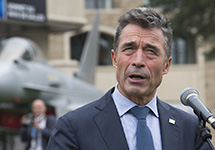
NATO Secretary General Anders Fogh Rasmussen outlined changes in the alliance security structure.
Source: www.nato.int
Miles Pomper
Nikolai Sokov
September 4, 3014
In a new piece in the National Interest, Vienna Center for Disarmament and Nonproliferation Policy (VCDNP) Nikolai Sokov, a former Russian arms control negotiator, and Center for Nonproliferation Studies Senior Research Associate Miles Pomper argue that this week’s NATO summit in Wales will mark a turning point away from US-Russian arms control and toward a more militarized relationship, including a potential renewed emphasis on nuclear weapons.
NATO leaders are gathering in Newport, Wales, September 4 and 5, in the wake of Russian intervention in Ukraine and alleged Russian violations of the Intermediate-Range Nuclear Forces (INF) Treaty. The summit is likely to mark the effective end of a debate about withdrawing the remaining US tactical nuclear weapons in Europe, which dominated discourse within the alliance for more than five years.
Indeed, the alliance may now feel pressure from some corners to boost its nuclear capabilities. It is likely too soon for members to agree upon new nuclear policy responses to Russian actions at this summit, but some debate is likely in the coming months and years. However, any proposal to increase the profile of nuclear deterrence in NATO’s defense strategy would have to contend with two major limitations. The first is financial—significant resources will be required simply to maintain the current nuclear posture, to say nothing about enhancements. The second is the poor fit between nuclear weapons and the nature of the perceived threat: these weapons are intended to deter a major aggression, whereas in Ukraine, Moscow relied on very limited—often clandestine—military involvement. Thus, any change of NATO nuclear policy can only amount to a political message rather than a substantive response.
In the meantime, Russia is already planning its counter-response to a NATO shift—even before NATO formulates its new policy. Almost any choice NATO will make will benefit the domestic agenda of the Russian government. It has already announced a plan to amend its military doctrine, which will probably openly classify NATO as an enemy for the first time since the Cold War. Russia’s substantive response will probably come in the form of accelerated research and development, as well as additional deployments of new long-range, precision-guided conventional weapons, which are more usable than nuclear ones. If confrontation between the East and the West continues to worsen, however, Sokov and Pomper argue that it is not out of the question that Russia’s response could come in the form of additional nuclear deployments, such as arming Iskander missiles in the Russian enclave of Kaliningrad with nuclear warheads.
